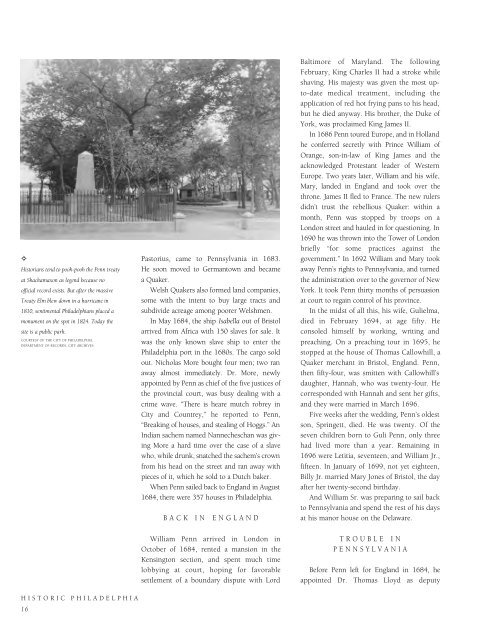Historic Philadelphia
An illustrated history of the city of Philadelphia, paired with the histories of companies, families and organizations that make the region great.
An illustrated history of the city of Philadelphia, paired with the histories of companies, families and organizations that make the region great.
You also want an ePaper? Increase the reach of your titles
YUMPU automatically turns print PDFs into web optimized ePapers that Google loves.
✧<br />
Historians tend to pooh-pooh the Penn treaty<br />
at Shackamaxon as legend because no<br />
official record exists. But after the massive<br />
Treaty Elm blew down in a hurricane in<br />
1810, sentimental <strong>Philadelphia</strong>ns placed a<br />
monument on the spot in 1824. Today the<br />
site is a public park.<br />
COURTESY OF THE CITY OF PHILADELPHIA,<br />
DEPARTMENT OF RECORDS, CITY ARCHIVES.<br />
HISTORIC PHILADELPHIA<br />
16<br />
Pastorius, came to Pennsylvania in 1683.<br />
He soon moved to Germantown and became<br />
a Quaker.<br />
Welsh Quakers also formed land companies,<br />
some with the intent to buy large tracts and<br />
subdivide acreage among poorer Welshmen.<br />
In May 1684, the ship Isabella out of Bristol<br />
arrived from Africa with 150 slaves for sale. It<br />
was the only known slave ship to enter the<br />
<strong>Philadelphia</strong> port in the 1680s. The cargo sold<br />
out. Nicholas More bought four men; two ran<br />
away almost immediately. Dr. More, newly<br />
appointed by Penn as chief of the five justices of<br />
the provincial court, was busy dealing with a<br />
crime wave. “There is heare mutch robrey in<br />
City and Countrey,” he reported to Penn,<br />
“Breaking of houses, and stealing of Hoggs.” An<br />
Indian sachem named Nannecheschan was giving<br />
More a hard time over the case of a slave<br />
who, while drunk, snatched the sachem’s crown<br />
from his head on the street and ran away with<br />
pieces of it, which he sold to a Dutch baker.<br />
When Penn sailed back to England in August<br />
1684, there were 357 houses in <strong>Philadelphia</strong>.<br />
BACK IN ENGLAND<br />
William Penn arrived in London in<br />
October of 1684, rented a mansion in the<br />
Kensington section, and spent much time<br />
lobbying at court, hoping for favorable<br />
settlement of a boundary dispute with Lord<br />
Baltimore of Maryland. The following<br />
February, King Charles II had a stroke while<br />
shaving. His majesty was given the most upto-date<br />
medical treatment, including the<br />
application of red hot frying pans to his head,<br />
but he died anyway. His brother, the Duke of<br />
York, was proclaimed King James II.<br />
In 1686 Penn toured Europe, and in Holland<br />
he conferred secretly with Prince William of<br />
Orange, son-in-law of King James and the<br />
acknowledged Protestant leader of Western<br />
Europe. Two years later, William and his wife,<br />
Mary, landed in England and took over the<br />
throne. James II fled to France. The new rulers<br />
didn’t trust the rebellious Quaker: within a<br />
month, Penn was stopped by troops on a<br />
London street and hauled in for questioning. In<br />
1690 he was thrown into the Tower of London<br />
briefly “for some practices against the<br />
government.” In 1692 William and Mary took<br />
away Penn’s rights to Pennsylvania, and turned<br />
the administration over to the governor of New<br />
York. It took Penn thirty months of persuasion<br />
at court to regain control of his province.<br />
In the midst of all this, his wife, Gulielma,<br />
died in February 1694, at age fifty. He<br />
consoled himself by working, writing and<br />
preaching. On a preaching tour in 1695, he<br />
stopped at the house of Thomas Callowhill, a<br />
Quaker merchant in Bristol, England. Penn,<br />
then fifty-four, was smitten with Callowhill’s<br />
daughter, Hannah, who was twenty-four. He<br />
corresponded with Hannah and sent her gifts,<br />
and they were married in March 1696.<br />
Five weeks after the wedding, Penn’s oldest<br />
son, Springett, died. He was twenty. Of the<br />
seven children born to Guli Penn, only three<br />
had lived more than a year. Remaining in<br />
1696 were Letitia, seventeen, and William Jr.,<br />
fifteen. In January of 1699, not yet eighteen,<br />
Billy Jr. married Mary Jones of Bristol, the day<br />
after her twenty-second birthday.<br />
And William Sr. was preparing to sail back<br />
to Pennsylvania and spend the rest of his days<br />
at his manor house on the Delaware.<br />
TROUBLE IN<br />
PENNSYLVANIA<br />
Before Penn left for England in 1684, he<br />
appointed Dr. Thomas Lloyd as deputy
















